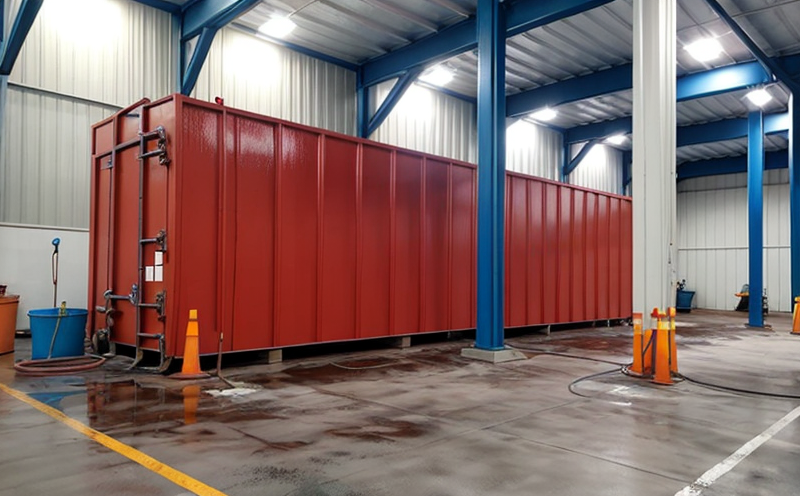ISO 9227 Neutral Salt Spray Corrosion Testing of Coatings
The ISO 9227 standard is a cornerstone in the assessment and certification of coatings used in industrial applications, particularly those exposed to corrosive environments. This test evaluates the resistance of coatings against neutral salt spray corrosion, which simulates atmospheric conditions found near coastal areas or in harsh industrial settings.
Neutral salt spray testing is critical for industrial manufacturing and processing industries where components are frequently exposed to moisture and corrosive agents. The test involves placing a specimen coated with paint or other protective layers into an environmentally controlled chamber. This chamber is then filled with a solution of 5% sodium chloride (NaCl) in distilled water, at 35°C ± 1°C. Specimens are exposed to this environment for specified durations under controlled conditions.
The primary objective of ISO 9227 testing is to assess the performance and durability of coatings against corrosion by measuring the time it takes for a critical amount of corrosion to occur on the specimen's surface. The critical value for the formation of rust is typically set at 10 micrometers (µm) of iron loss over a specified period.
The test setup includes specialized equipment such as salt fog chambers, temperature and humidity control systems, and automated data recording devices. These instruments ensure precise environmental conditions that mimic real-world exposure scenarios. Specimens are placed in the chamber with their coated sides facing upwards to facilitate uniform corrosion attack.
Before testing begins, specimens must be thoroughly cleaned of any dirt or contamination. They are then allowed to dry completely before being mounted on a holder within the chamber. The mounting process ensures that the coating remains intact and exposed only to the corrosive environment. Specimens are typically tested in batches of 10–20 units.
During testing, specimens are visually inspected at regular intervals for the appearance of rust or other signs of corrosion. Once the critical value is reached, the test is terminated, and the time elapsed since immersion determines the coating's resistance to neutral salt spray corrosion. The results of this test provide valuable data for quality control, product development, and regulatory compliance.
The application of ISO 9227 testing extends beyond mere certification; it also serves as a tool for continuous improvement in material science and engineering practices. By understanding the failure mechanisms under controlled conditions, manufacturers can optimize their coating formulations to enhance performance and longevity. This test is especially relevant in industries like automotive manufacturing, aerospace, marine engineering, and oil & gas processing.
The results of ISO 9227 testing are used for quality control purposes, product development, and compliance with international standards such as ISO 12937-4:2016. This ensures that coatings meet stringent requirements set by regulatory bodies and industry stakeholders. The test's reliability is further enhanced by its widespread adoption in academic research and industrial practice.
Why It Matters
The ISO 9227 neutral salt spray corrosion testing of coatings is essential for ensuring the longevity and performance of components used in harsh environments. In industries such as automotive, aerospace, marine engineering, and oil & gas processing, exposure to corrosive elements can significantly reduce the lifespan of critical components.
- Enhanced Durability: By subjecting coatings to controlled neutral salt spray conditions, manufacturers can identify the most durable materials that withstand harsh environmental conditions.
- Regulatory Compliance: Adherence to ISO 9227 standards ensures compliance with international regulations and industry best practices.
- Quality Control: Regular testing helps in maintaining high-quality products, reducing maintenance costs, and extending the operational life of equipment.
- Product Development: The insights gained from this test can be used to improve product designs and materials, leading to more robust solutions for industrial applications.
The importance of ISO 9227 testing lies in its ability to provide objective data that can guide decision-making processes. It ensures that the coatings used meet specified performance criteria under defined environmental conditions, thereby enhancing reliability and safety in critical industrial operations.
Applied Standards
The ISO 9227 standard is widely recognized for its rigorous approach to neutral salt spray corrosion testing of coatings. This international standard is specifically designed to evaluate the resistance of coatings against atmospheric corrosion by simulating coastal environments and other corrosive conditions.
ISO 12937-4:2016 also provides supplementary guidelines on the use of ISO 9227, offering additional context for specific applications. These standards are crucial for ensuring consistency in testing protocols across different industries and regions. Adherence to these standards ensures that results from various laboratories can be compared reliably, promoting trust and interoperability in global markets.
Other relevant international standards include ASTM B117:2020, which specifies the salt spray apparatus and procedure for the neutral salt fog test. This standard is often used alongside ISO 9227 to provide comprehensive testing protocols that cover both laboratory-based and field conditions.
Competitive Advantage and Market Impact
- Enhanced Reputation: Companies that comply with ISO 9227 standards gain a reputation for quality and reliability, which can significantly enhance their market position.
- Better Product Performance: By ensuring that coatings meet the stringent requirements of this test, manufacturers can offer products with superior durability and resistance to corrosion.
- Cost Savings: While initial testing costs may be high, long-term savings are realized through reduced maintenance and replacement expenses. Additionally, compliance with ISO 9227 can lead to increased sales by appealing to environmentally conscious customers.
- Innovation Opportunities: The insights gained from ISO 9227 testing can inspire new product development, leading to innovative solutions that meet evolving market demands.
The impact of ISO 9227 testing extends beyond individual companies. It contributes to the overall improvement of industrial coatings and paints, fostering a more robust and reliable supply chain. By setting high standards for corrosion resistance, this test plays a pivotal role in advancing the field of materials science and engineering.





